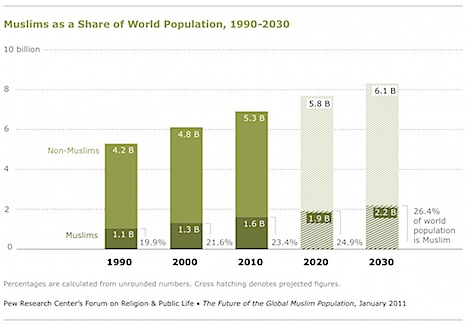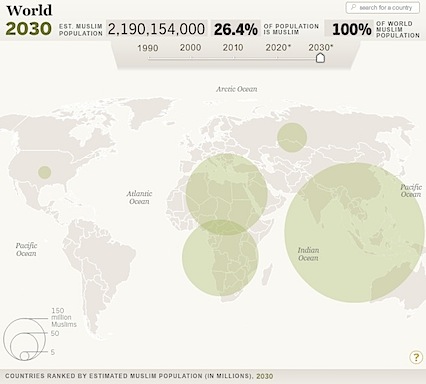The global spread of Islam: Threat or opportunity?
The world’s Muslim population is expected to increase by about 35% in the next 20 years, rising from 1.6 billion in 2010 to 2.2 billion by 2030,.
The world's Muslim population will grow twice as fast as the non-Muslim population in the next 20 years, when Muslims are expected to make up more than a quarter of the global population, a Pew Forum study predicts.
The study, called The Future of the Global Muslim Population, projects that in 2030 Muslims will make up 26.4 per cent of the world's population, which is expected to total around 8.3 billion people by then.
More than six in 10 followers of Islam will live in the Asia-Pacific region in 2030, and nuclear Pakistan, which has seen a rise in radical Islam in recent months, will overtake Indonesia as the world's most populous Muslim nation.
In Africa, the Muslim population of the sub-Saharan country of Nigeria will be greater than that of Egypt in 20 years.
And in Europe, Pew predicts the Muslim population will grow by nearly a third in 20 years, from 44.1 million people, or six per cent of the region's inhabitants in 2010, to 58.2 million or eight per cent of the projected total population by 2030.
Some European Union (EU) countries will see double-digit percentages of Muslims in their population by 2030: Belgium's Muslim population is projected to rise from six per cent to 10.2 per cent over the next 20 years, while France's is expected to hit 10.3 per cent in 2030, up from 7.5 per cent today.
In Sweden, Muslims will comprise nearly 10 per cent of the population compared to less than five per cent today.
Britain's Muslim population is predicted to rise from 4.6 per cent to 8.2 per cent by 2030, and 9.3 per cent of the population of Austria is forecast to be Muslim by then, compared to less than six per cent of residents of the alpine country now.
Russia, which is not a member of the EU, will continue to have the largest Muslim population in absolute terms in Europe in 2030, with 18.6 million Muslims or 14.4 per cent of the total population of the vast country.
The United States, meanwhile, is projected to have a larger absolute number of Muslims by 2030 than any European countries other than Russia and France, but proportionally, Muslims will make up a much smaller percentage of the population of the US than they do in Europe.
The Muslim share of the US population is projected to grow from its current level of less than one per cent to 1.7 per cent by 2030, making Muslims "roughly as numerous as Jews or Episcopalians are in the US," the study says.



